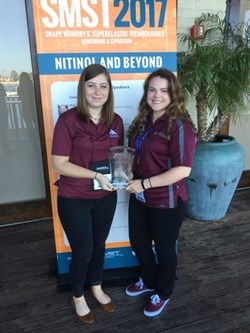 Two undergraduate students from the Department of Aerospace Engineering at Texas A&M University competed in the second annual Consortium for the Advancement of Shape Memory Alloy Research and Technology (CASMART) student design competition at the 2017 Shape Memory and Superelastic Technologies (SMST) conference in San Diego, California.
Two undergraduate students from the Department of Aerospace Engineering at Texas A&M University competed in the second annual Consortium for the Advancement of Shape Memory Alloy Research and Technology (CASMART) student design competition at the 2017 Shape Memory and Superelastic Technologies (SMST) conference in San Diego, California.
In this competition, students were challenged to design a collapsible habitat to be used during transport to Mars that could be automatically deployed using embedded shape memory alloy components. Madalyn Mikkelsen and Elise Koock, representing the M2AESTRO lab student team under the direction of Dr. Darren Hartl, placed first in the design portion of the competition.
Mikkelsen and Koock, along with Lane Kirstein and Luis Gonzales, worked on the problem for a semester as part of a special undergraduate directed research course under the direction of Hartl, assistant professor in the department. With graduate student Pedro Leal assisting, the group of two juniors and two sophomores competed against teams exclusively comprised of graduate students and graduating seniors.
Mikkelsen and Koock were chosen to represent the full team in San Diego and presented their final design to peers, industry experts and a panel of 13 distinguished judges.
A second design competition focusing on materials development was won by another Texas A&M team from the Department of Materials Science and Engineering, advised by department head Dr. Ibrahim Karaman.
This impressive showing follows another win by students from the department in the first annual CASMART student design competition two years ago, further asserting Texas A&M as a leader in the design and development of shape memory alloy materials and applications.